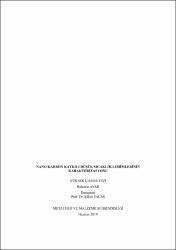| dc.contributor.advisor | Talaş, Şükrü | |
| dc.contributor.author | Ayar, Bahattin | |
| dc.date.accessioned | 2019-10-25T13:20:51Z | |
| dc.date.available | 2019-10-25T13:20:51Z | |
| dc.date.issued | 2019 | en_US |
| dc.identifier.uri | https://hdl.handle.net/11630/7093 | |
| dc.description.abstract | Elektrik ve elektronik endüstrisinde elektronik parçaların kolaylıkla birleştirilmesinde ve ayrıca elektriksel iletkenlik sağlamak amacıyla lehim yapılmaktadır. Lehimlerin dayanımları ve elektronik özellikleri yani iletkenlikleri iyileştirildiğinde daha az enerji kaybı ve uzun hizmet süresi sağlanabilecektir.
Bu projede endüstriyel olarak kullanılan lehimlerin mekanik, fiziksel ve elektriksel özelliklerinin iyileştirilmesi amaçlanmıştır. Bu projede, kurşunlu ve kurşunsuz lehimlere ergimede, ağırlıkça yüzde nano aktif karbon (0 = katkısız, 1 = 0,1, 2 = 0,2, 3 = 0,3, 4 = 0,45) oranlarında ilave edilmiştir. Numuneler daha sonra hassas kesme cihazında kesilip SEM görüntüleri alınmıştır. DTA ile ergime noktası tayini ve faz dönüşümleri karakteristikleri incelenmiştir. XRD yöntemi ile fazların tespiti yapılmış ve sahip oldukları fazların sayısı ve türünde değişim olup olmadığı incelenmiştir. Ayrıca üretilen lehimler Cu plakalar üzerine lehim yapılarak çekme deneyine tabi tutulmuştur. Bunun dışında numunelere basma deneyi, elektriksel özdirenç ölçümü ve mikrosertlik deneyleri yapılmıştır. Bu araştırmada, lehimleme işlemi, yumuşak lehimleme prensipleri ve aktif karbon hakkında geniş bilgi verilmiş ve bu doğrultuda deneysel çalışmalar yapılmıştır. | en_US |
| dc.description.abstract | In the electrical and electronics industry, solder is easily assembled with electronic components and also to provide electrical conductivity. When the strengths and electronic properties of the solders, ie their conductivity, are improved, less energy loss and longer service life will be achieved. In this project, it is aimed to improve the mechanical, physical and electrical properties of industrially used solders.
In this project, lead and lead-free solders were produced by adding percent by weight nano-active carbon (0 = no additive, 1 = 0.1, 2 = 0,2, 3 = 0,3, 4 = 0,45) while melting. The samples were then cut on a precision cutting device and SEM images were taken. Melting point determination and phase transformation characteristics of the produced samples were investigated by DTA. The phases were determined by XRD method and the changes in the number and type of phases were examined. In addition, the produced solders were soldered onto copper plates and subjected to a tensile test. Apart from this, samples were subjected to tensile test, electrical resistivity measurement and microhardness tests. In this study, extensive information about soldering process, soft soldering principles and activated carbon was given and experiments were carried out in this direction. | en_US |
| dc.language.iso | tur | en_US |
| dc.rights | info:eu-repo/semantics/openAccess | en_US |
| dc.subject | Kurşunsuz Lehim | en_US |
| dc.subject | Kurşunlu Lehim | en_US |
| dc.subject | Aktif Nano Karbon | en_US |
| dc.subject | İletkenlik | en_US |
| dc.title | Nano karbon katkılı düşük sıcaklık lehimlerinin karakterizasyonu | en_US |
| dc.title.alternative | The characterization of low melting point solders containing nano carbon | en_US |
| dc.type | masterThesis | en_US |
| dc.department | Mühendislik Fakültesi | en_US |
| dc.identifier.startpage | 1 | en_US |
| dc.identifier.endpage | 63 | en_US |
| dc.relation.publicationcategory | Tez | en_US |



















